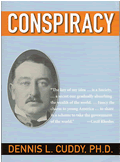THE GRAY GHOST AND THE DARK ACT
by Steven Neill
November 8, 2015
NewsWithViews.com
FUSAG, Comes to America
“This damned secrecy thing is rather annoying particularly as I doubt if it fools any one. Every time I make a speech I have to say now remember you have not seen me- a voice crying in the wilderness.” — Letter George Smith[1] Patton to Beatrice Patton
Few acts of WWII deception were as effective as Operation Quicksilver, the creation of First United States Army Group, aka FUSAG.[2] Using inflatable tanks,[3] planes, jeeps and bogus infrastructure, the 1944 deception plan designed to induce the Germans to hold troops away from Normandy in belief that the Normandy landing was only a feint and that the major invasion would come in the Pas-de-Calais area of France. Lead by none other than ole’ Blood and Guts General Patton, the “Ghost Army,”[4] fooled German military leadership into believing that the D-Day landings at Normandy, the largest invasion in the history of the world, were a decoy.
Quicksilver was subdivided into six sub-plans numbered I through VI.[5] Quicksilver I was the basic "story" for Fortitude: FUSAG (Ninth Air Force associated), in southeast of England, to land in Pas-de-Calais after German reserves were committed to Normandy. Quicksilver II was the radio deception plan of Quicksilver, involving the apparent movement of units from their true locations to southeastern England. Quicksilver III was the display of dummy landing craft, including associated simulated wireless traffic and signing of roads and special areas. Quicksilver IV was the air plan for Quicksilver, including bombing of the Pas-de-Calais beach area, the dropping of dummy parachutists east of Calais and tactical railway bombing immediately before D-Day. Quicksilver V was increased activity around Dover (giving impression of extra tunneling, additional wireless stations), to suggest embarkation preparations. Quicksilver VI was night lighting to simulate activity at night where dummy landing craft were situated.
The operation was carried out by means of false radio signals purporting to show units massing in southeastern England, together with false reports to German intelligence by double agents.[6] As history shows, it was wildly successful. Hitler sent over a million troops to Calais to fortify the city. It would be one of his greatest mistakes. Mighty reinforcements for the Normandy front waited at Calais,[7] specifically, the tanks and infantry of the German 15th Army. At a midnight conference on June 9, Hitler cancelled orders to send those forces to Normandy. They were to stay at the Pas de Calais. Indeed, even reinforcements currently on the way to Normandy were to be diverted[8] to Calais. The phantom army had won its battle.
The Allied imposture continued for weeks. The presence of FUSAG would keep German forces at the Pas de Calais out of the Normandy battle, even after Patton arrived at Normandy as the head of the US Third Army. The Germans thought that FUSAG formations were being cannibalized by Eisenhower to replace losses in Normandy.
By mid-August, it no longer mattered whether the Germans still believed in FUSAG or not. The German defenders of the Normandy front—the Seventh Army and Fifth Panzer Army—had been cut apart. Patton’s Third Army was racing across France and the German defenders of the Pas de Calais—now threatened from the landward side by real divisions rather than phantom ones—was heading out of the region and out of the battle.
While absolutely amazing, the use of deception by the US government is, unfortunately not reserved for enemy countries, but rather has been used continuously on the American People since the early days of the 20th century. The 1912 election was clearly a case of an orchestrated event as the popular sitting US President William Taft was replaced with a cold, indifferent and unknown Woodrow Wilson because of the intervention of Theodore Roosevelt.[9] Wilson in turn pushed through the Federal Reserve and purposely got the US involved[10] in WWI.[11] There is strong evidence that Roosevelt knew the Japanese[12] were going to attack the US to once again get us involved in a world war. False Flags were the norm in both Vietnam with the Tonkin Gulf Incident[13] in August 1964, and the invasion of Iraq.[14] But war is not the only use of massive government deception, for instance the NSA,[15] the Patriot Act[16] and TPP.[17] Now, another monstrosity is set to attack American civil liberties in the form of H.R 1599, the Safe and Accurate Food Labeling Act of 2015 (or the nickname given by its opponents: Deny Americans the Right to Know (DARK) Act).
“One of the trends we’re seeing in food and agriculture is more and more consumers wanting to know things about their food and where and how it’s grown and what’s in it,” — Dan Glickman[18]
The one question that looms the largest over this Act is whether or not you have the right to know what is in the food[19] you eat. According to many concerned scientists, doctors, researchers, some 300 companies and millions[20] of concerned citizens, the answer is yes. But according to many multinational corporations, the answer is no. On July 24, 2015, the members of the US House of Representatives showed America just how much they honor their constituents by overwhelmingly passing H.R 1599,[21] the Safe and Accurate Food Labeling Act of 2015 (or the nickname given by its opponents: Deny Americans the Right to Know (DARK) Act).
The DARK Act was introduced by U.S. Rep. Mike Pompeo,[22] (R-Kan.) and G.K. Butterfield (D-N.C.) [23] with the deliberate intent to overturn state labeling laws that have passed in Vermont, Connecticut, and Maine, and stop any future laws from passing. In the last two years, 30 States have introduced legislation requiring the labeling of GMO foods and the food industry has spent billions in stopping them.
The four main points of the DARK Act[24] are:
1.
It would negate all existing GMO labeling laws thus codifying the
current, broken system.
2. The bill would give jurisdiction over non-GMO
certification to the U.S. Department of Agriculture (USDA), which
would use GMO “safety” review system based on industry
science.
3. There is language in the bill that preempts
state and local laws regarding the limiting of production
of GMO crops, not just labeling.
4. The bill would expand the definition of “natural”
to include some genetically modified ingredients. In January, Associated
Press-GfK ran a poll and found 66%
of Americans[25] support the labelling of genetically modified
ingredients on food packages. Other polls[26]
were run with similar results. Labeling GMO ingredients is popular
with the American people yet, this Bill passed overwhelmingly in
the House. Why would that happen?
“People will have Roundup Ready soya whether they like it or not” – Ann Foster,[27] spokesperson for Monsanto
Well, just follow the money. The agribusiness sector and food and beverage industry “donated” over $29.9 million,[28] an average of $108,900 per member during the 2014 election cycle, to the 230 Republicans and 45 Democrats who voted to pass the bill. The 138 Democrats and 12 Republicans Congress members who voted against it received nearly one third less at an average of $38,977 per lawmaker.
Since 1990, more than $115.1 million (an average of $418,644 per member) has gone into the election campaign coffers of those who voted for this act whereas only $25.8 million for those who voted against it ($171,785 per member). These figures certainly show that there is more than plants that are green in agribusiness.
“Today’s vote to deny Americans the right to know what’s in their food and how it’s grown was a foregone conclusion. This House was bought and paid for by corporate interests, so it’s no surprise that it passed a bill to block states and the FDA from giving consumers basic information about their food.” -Scott Faber,[29] senior vice president of government affairs for Environmental Working Group (EWG).
“We’re confident the Senate will defeat the DARK Act,” continued Faber. “We continue to hope that thoughtful food companies which listen to their customers will work with consumer groups to craft a non-judgmental GMO disclosure to put on the back of food packaging. Americans should have the same right as citizens of 64[30] other countries to know what’s in their food and how it’s grown.”
"Monsanto has millions of dollars to dedicate to this fight, and this vote shows they are skilled in using those vast resources to buy votes in Congress.” — Vermont Gov. Peter Shumlin[31]
Just like the massive public outcry against TPP, millions of Americans contacted their Congressman to voice opposition to this travesty and just like on TPP;[32] Congress[33] simply followed the money and voted yes to allowing Monsanto to continue in its evil ways.
“The safety and benefits of these ingredients are well established.” —Monsanto[34]
After decades of lying about dioxin, rBGH,[35] glyphosate,[36] Nutrasweet,[37] PCB’s[38] and DDT[39] being safe, Monsanto has a another poison to peddle on the uninformed, GMO’s. (40) Using the reliable tactic of lying to Congress,[41] buying politicians/academics and paying the right people to falsify[42] numerous reports Monsanto has often been able to shut down their opposition. This strategy has served them well for decades and so they still routinely use it as their business model. But every so often, the truth will slip out as has happened on 9/5/15 when New York Times writer Eric Lipton[43] wrote the following article: “Food Industry Enlisted Academics in G.M.O. Lobbying War, Emails Show” exposing collusion between Dr. Kevin Folta,[44] a respected Chairman of the Horticultural Department at the University of Florida and Monsanto to advance the GMO agenda.
This article is an exercise in damage control as it severely tries to turn this into a struggle between the corporations promoting GMO’s and those producing Organic foods. It most certainly is anything but that. This is a life and death struggle over who will ultimately control one of the most important essentials of life; food.
Lipton and the NY Times were able to get hundreds of emails from the nonprofit group “Right to Know”[45] after the group submitted a Freedom of Information Act request. Based upon the emails, the article paints a very incestuous relationship between the “independent” Folta and the GMO corporations. However, the article falls far short[46] on exposing the vast scale of the collusion.
“Academic research is often dictated by corporations that endow professorships, give money to universities, and put their executives on education boards.” — Jill Richardson[47]
“Things like the U of F has received Syngenta (>$10million), Monsanto (>$1million), Pioneer (>$10million), and BASF (>$1million) which no doubt allowed Folta to roam like the Nazgûl over the internet, via his twitter account, blog, podcast, and OpEds, squelching dissent and ridiculing GMO critics wherever he prowled.
The other thing Lipton and the NY Times failed to bring out was the army of “independent” academics also working with the biotech industry. Names like Profs. Bruce Chassy (University of Illinois) and Alan McHughen (University of California, Riverside) who were able to destroy the credibility of a Russian scientist and GMO critic Irina Ermakova through malignant subterfuge. Prof. Calestuous Juma (Harvard University) longtime advocate of GMOs for Africa and Prof. Wayne Parrott (University of Georgia) a serial intervener in academic GMO debates.
Prof. Roger Beachy (Danforth Center, formerly USAID). Beachy is the proverbial example of the biotech industry strategy: to respond rapidly to a report or publication critical of some aspect of the technology with a multi-author “rebuttal”
Prof. CS Prakash (Tuskegee University) is the convener of the influential listserv AgBioWorld. AgBioWorld was the all-important channel for a petition signed by three thousand scientists calling for the retraction of a 2001 scientific paper showing GMO contamination of Mexican corn.
Prof. Ron Herring (Cornell) who has helped to promote GMOs in India and fought to stifle the farmer suicide debate in India.
Nina Fedoroff (Penn State) as the 2011-2012 President of the American Association for the Advancement of Science is the most prominent of the scientists mentioned in the Times emails and, coincidentally is also a contributor to the NY Times. The AAAS is the foremost scientific body in the US and from her Presidency position, Fedoroff, coordinated and signed a letter on behalf of 60 prominent scientists that was sent to EPA as part of an effort to defeat a pesticide regulatory effort. Working with prominent lobbyist Stanley Abramson, Fedoroff is credited in the emails with “moving the ball far down the field”. Yet Fedoroff’s name is kept out of the main article and her position is not mentioned at all.
So one of the most important points of the cover-up is missing from Lipton’s article, that academia’s most vocal GMO defenders, and some of its most prominent scientists, are part of this campaign of lies and deceit sponsored by the biotech industry. By omitting this and other aspects of the story, the NY Times shows it is part of the consortium to discredit those wanting to label GMO’s.
More supposedly “independent” academics who speak in favor of biotechnology, self-reportedly out of personal passion are included in the emails. Names like Dr. Steve Savage, Karl Haro von Mogel of Biofortified, Mischa Popoff (of the Heartland Institute) and Jon Entine (then affiliated with George Mason University and now head of the Genetic Literacy Project and a Forbes Magazine columnist). All are exposed as biotech insiders by the emails but omitted in the article.
But perhaps the biggest of all revelations within these emails is the connivance of senior university administrators, especially at Cornell University. The NY Times article focuses on the misdeeds of Mississippi State University Vice President David Shaw. But, looped into one email string, along with the PR firm Ketchum and Jon Entine are various Cornell email addresses and names. These are ignored by Lipton, but the email addresses belong to very senior members of the Cornell administration. They include Ronnie Coffman (Director of Cornell’s College of Agriculture and Life Science) and Sarah Evanega Davidson (now director of the Gates-funded Cornell Alliance for Science).”
|
|
This string of email’s are a godsend to those opposed to GMO and the false labeling guidelines contained in the DARK Act. It is time to fight the good fight and get involved in stopping this tragedy or we will forever be in the DARK about our food. We must shed the blinders from our eyes and stop being victims of the illusion that Congress works for us, they don’t and haven’t for decades. We must be vocal and tireless, to do otherwise is to surrender all rights to safe foods as Monsanto and cronies continue to poison the globe. We must stop the DARK Act!
“Monsanto should not have to vouchsafe the safety of biotech food.... Our interest is in selling as much of it as possible. Assuring its safety is the FDA’s job” —Phil Angell, Director of Corporate Communications, Monsanto [48]
© 2015 - Steven Neill - All Rights Reserve












 Share
This Article
Share
This Article




